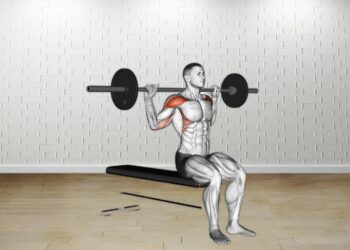The reverse pec deck fly is an exercise done on specialized equipment to target the rear deltoids. The exercise also engages the trapezius and rhomboid muscles. But reverse pec deck machines are not that common these days.
You’re more likely to find a reverse pec deck machine in a hard-core bodybuilding gym than in a general-purpose fitness center. And if you’re working out at home, you most likely won’t have access to this equipment. That’s why it’s a good idea to have a toolbox of reverse pec deck alternative exercises that you can use to target your posterior deltoids.
In this article, we lay out nine reverse pec deck alternatives that are just as good and in some cases—better than the original.
Reverse Pec Deck Muscles Worked
The main muscles worked in the reverse pec deck are:
Posterior deltoids: The posterior deltoid pulls the upper arm back and down. The backward horizontal movement of the reverse pec deck covers the backward part but does move the rear delts down diagonally. In selecting the best reverse pec deck alternatives, we have favored exercises that bring the arms down diagonally and back to better simulate the anatomical function of the muscle.
Middle trapezius and rhomboids: The trapezius, or traps, is a kite-shaped muscle that covers the top half of your mid-back. It has the dual function of shrugging your shoulders and pulling the shoulder blades together. The rhomboids, located between the scapula, work with the traps to bring the shoulder blades together when you perform the reverse pec deck exercise.
Level Up Your Fitness: Join our 💪 strong community in Fitness Volt Newsletter. Get daily inspiration, expert-backed workouts, nutrition tips, the latest in strength sports, and the support you need to reach your goals. Subscribe for free!
9 Best Reverse Pec Deck Alternatives
1. Cable Reverse Fly
The cable reverse fly is an excellent exercise to isolate the rear delts and move them through their full anatomical range of motion. The diagonal direction of movement follows the direction of the muscle fibers.
Using cables allows you to keep constant tension on the working muscle. Cables are also an early phase loaded form of resistance, being harder at the beginning and easier at the end. This is the same as the resistance curve of the rear delts.
How to do it:
- On a double cable pulley machine, set the pulleys to the highest setting.
- Pull the pulley handles out.
- Cross your forearms and hold the cable ends in your opposing hands.
- Move backward until your crossed arms are at chest level.
- Pull your arms back diagonally towards the wall behind you while maintaining a slight bend in your elbows.
- Maintaining total control, go back to the starting position and repeat.
Pro tip: You only need to use a very lightweight when doing this exercise. The posterior delts—a very small muscle—responds best to a higher rep range, so we recommend pyramiding down from 30 reps on your first set to 15 reps on your last.
Benefits of the Cable Reverse Fly:
- Allows for the ideal direction of motion under resistance.
- Constant tension on the muscle.
- Early phase loaded.
In This Exercise:
- Target Muscle Group: Rear deltoids
- Secondary Muscles: Trapezius, rhomboids
- Type: Hypertrophy
- Mechanics: Isolation
- Equipment: Machine
- Difficulty: Intermediate
- Best Rep Range:
- Hypertrophy: 20-30
Check out the in-depth cable reverse fly guide here!
2. Resistance Band Reverse Fly
If you don’t have a double cable pulley machine in your home gym, you can still do a version of the cable reverse fly. By substituting resistance bands for cables, you get a cost-effective alternative that is almost as good.
The main difference between the resistance band and cable versions of the reverse fly is that with bands, the exercise is easier at the start and harder at the finish. This runs counter to the natural strength curve of the muscle. Besides, the resistance band reverse fly is a very good rear delt exercise.
How to do it:
- Attach two bands to anchor points a few inches above your head. About three feet should separate the anchor locations.
- Cross your forearms and hold the ends of the bands in your opposing hands.
- Move backward until your crossed arms are at chest level.
- From this starting position, pull your arms back diagonally towards the wall behind you while maintaining a slight bend in your elbows.
- Return to the starting position and repeat.
Pro tip: The hardest part of this exercise will be the last third, where you bring the arms out level with the hips. Hold the end position for a couple of seconds to really feel the rear delt contraction before returning under control to the start position.
Benefits of the resistance band reverse fly:
- Allows for the ideal direction of motion under resistance.
- Low-cost equipment.
- Ability to adjust the angle of movement.
In This Exercise:
- Target Muscle Group: Rear deltoids
- Secondary Muscles: Trapezius, rhomboids
- Type: Hypertrophy
- Mechanics: Isolation
- Equipment: Resistance band
- Difficulty: Beginner
- Best Rep Range:
- Hypertrophy: 20-30
3. Bent-Over Dumbbell Reverse Fly
The bent-over dumbbell reverse fly is probably the most popular exercise in gyms to hit rear delts. It does a good job of working through the same horizontal plane as the reverse pec deck but doesn’t traditionally bring the arms down to the sides. You can improve on the angle of motion by bringing your arms out and down on a diagonal as you pull the elbows back.
How to do it:
- With a pair of dumbbells in your hands, stand with your feet shoulder-width apart.
- Lean forward until your body is at a 30-degree angle to the floor while maintaining natural curvature in your spine.
- Your palms should be facing each other as you hang your arms down in front of your body. Keep your elbows locked in that position while bending them just a little.
- Hinge from the shoulder joint to lift the arms diagonally towards the ceiling. In the end position, they should be in line with your hips.
- Lower under control and repeat.
Pro tip: Do not use heavy dumbbells for this exercise. If you do, the upper traps and middle delts will take over, with your rear delts merely going along for the ride.
Benefits of the bent-over dumbbell reverse fly:
- Works the rear delts through the horizontal plane.
- Allows for scapular retraction.
In This Exercise:
- Target Muscle Group: Rear deltoids
- Secondary Muscles: Trapezius, rhomboids
- Type: Hypertrophy
- Mechanics: Isolation
- Equipment: Dumbbell
- Difficulty: Intermediate
- Best Rep Range:
- Hypertrophy: 20-30
Check out the in-depth bent-over dumbbell reverse fly guide here!
4. Lying Dumbbell One-Arm Rear Delt Raise
The lying one-arm dumbbell rear delt raise does a good job of moving through the functional range of the rear delts. To achieve that movement, you have to be lying on the floor on your side, which isn’t that comfortable. Use a very light weight so you can control the movement against gravity.
How to do it:
- With a light dumbbell in your upper hand, lie on your side. Your knees and feet should be stacked on top of each other.
- Your arm should be straight out in front of you with the dumbbell on its end resting on the floor.
- The other hand should be at a diagonal angle to your torso, resting on the ground or under your head for support.
- Lift the dumbbell diagonally towards the ceiling so that it is in line with your hip. Do not bend your elbow.
- Return to the starting position while maintaining control, then repeat.
Pro tip: Don’t lift the arm too high, or you will lose the contraction in the rear delts. In the end position, the dumbbell should be about six inches from your hip.
Level Up Your Fitness: Join our 💪 strong community in Fitness Volt Newsletter. Get daily inspiration, expert-backed workouts, nutrition tips, the latest in strength sports, and the support you need to reach your goals. Subscribe for free!
Benefits of the lying one-arm dumbbell rear delt raise:
- Works each side individually.
- Follows the direction of the muscle fibers.
In This Exercise:
- Target Muscle Group: Rear deltoids
- Secondary Muscles: Trapezius, rhomboids
- Type: Hypertrophy
- Mechanics: Isolation
- Equipment: Dumbbell
- Difficulty: Intermediate
- Best Rep Range:
- Hypertrophy: 15-30
5. Bent-Over One-Arm Banded Rear Delt Raise
The bent-over one-arm banded rear delt raise is a unilateral exercise that involves the same horizontal plane of motion as the reverse pec deck fly. The versatile angling of the band, however, means that you can more precisely move your arm in line with the diagonal direction of the muscle fibers.
By using a band instead of dumbbells, you can keep constant tension on the working muscle.
How to do it:
- Connect a resistance band firmly to a floor-level anchor.
- Stand 3 feet away from the anchor point and side-on to it. Bend over so your body is parallel to the ground with feet slightly wider than shoulder width. Take hold of the band handle with your outside hand.
- Reposition yourself so the band is taut and your arm is extended between your feet.
- Pivot from the shoulder joint to lift the arms diagonally towards the ceiling, while keeping the elbows slightly bent.
- Lower under control and repeat.
Pro tip: Use a light resistance band to allow for full control. Hold the contracted position for a two-second count.
Benefits of the bent-over one-arm banded rear delt raise:
- Follows the direction of the muscle fibers.
- Works one arm at a time.
In This Exercise:
- Target Muscle Group: Rear deltoids
- Secondary Muscles: Trapezius, rhomboids
- Type: Hypertrophy
- Mechanics: Isolation
- Equipment: Resistance band
- Difficulty: Intermediate
- Best Rep Range:
- Hypertrophy: 20-30
6. YTWs
If you don’t have any light dumbbells or resistance bands, you can effectively target the same muscles as the reverse pec deck with YTWs. In this exercise, you will alternate between three positions, each of which will target one of the three major muscles engaged by the reverse pec deck: the posterior deltoids, the middle traps, and the rhomboids.
How to do it:
- Lie face down on an exercise mat and rest your chin on the mat. Extend your arms above your head in a diagonal motion so they end up in a ‘Y’ position. Your thumbs should be pointing up.
- Squeeze your shoulder blades together as you raise your arms a few inches off the floor.
- Lower and repeat 10 times.
- Bring your arms down to form a “T” now. Your arms should be extended to your sides and in line with each other. Turn your palms towards the ground.
- Bring your arms up a few inches above the ground by squeezing your shoulder blades together.
- Lower and repeat 10 times.
- Now extend your hands out from your hips and lower your arms so they are diagonal. Your palms should be pointing down.
- Lift your arms off the floor by squeezing the shoulder blades together.
- Lower and repeat 10 times.
Pro tip: Besides being an effective stand-alone exercise if you don’t have access to equipment, YTWs are an excellent finishing exercise at the end of your delt workout. You can also do this exercise with light dumbbells in your hands.
Benefits of the YTW:
- It can be done with no equipment.
- Provides a great muscle burn in the rear delts and upper traps.
- Excellent finishing exercise.
In This Exercise:
- Target Muscle Group: Rear deltoids
- Secondary Muscles: Trapezius, rhomboids
- Type: Hypertrophy
- Mechanics: Isolation
- Equipment: None
- Difficulty: Beginner
- Best Rep Range:
- Hypertrophy: 20-30
7. Incline Bench Rear Delt Fly
The incline bench rear delt fly is a more strict version of the rear delt fly that eliminates momentum. That’s because you are prone on an incline bench. This exercise is a lower back-friendly variation of the seated bent-over rear delt fly.
How to do it:
- Adjust the angle on an incline bench to 45 degrees. Lay prone on the bench with a light pair of dumbbells in your hands. Your torso should be pushed into the bench as you firmly place your feet on the ground.
- Hang your arms down in front of you with the palms facing each other and the elbows slightly bent.
- Lift the arms diagonally towards the ceiling.
- Lower under control and repeat.
Pro tip: Throughout this exercise, keep your chest flat on the bench.
Benefits of the incline bench rear delt fly:
- Prevents momentum.
- Lower-back friendly.
In This Exercise:
- Target Muscle Group: Rear deltoids
- Secondary Muscles: Trapezius, rhomboids
- Type: Hypertrophy
- Mechanics: Isolation
- Equipment: Dumbbell
- Difficulty: Intermediate
- Best Rep Range:
- Hypertrophy: 20-30
8. Lying Supine Cable Raise
The lying supine cable raise is a stricter version of the standing cable reverse fly. That’s because you’re lying on a bench. This keeps momentum out of the movement. It’s also easier on your lower back.
How to do it:
- Position a flat bench between a cable crossover machine. Set pulleys in their highest position. Lie on the bench and grab the handles in a crisscross manner.
- Bring the cables down and to the sides until your arms are parallel to the floor. Maintain a slight bend at the elbow but keep the arms locked so that movement originates at the shoulder joint.
- Return to the start position under control.
Pro tip: Do not bring the cables lower than your waistline or you will transfer the emphasis from the rear to the middle deltoids.
Benefits of the lying supine cable raise:
- Prevents momentum.
- Lower-back friendly.
In This Exercise:
- Target Muscle Group: Rear deltoids
- Secondary Muscles: Trapezius, rhomboids
- Type: Hypertrophy
- Mechanics: Isolation
- Equipment: Machine
- Difficulty: Intermediate
- Best Rep Range:
- Hypertrophy: 20-30
9. Bent-Over One-Arm Cable Fly
The bent-over one-arm cable fly is a unilateral version of the bent-over cable reverse fly. This allows you to work each side of the delts individually to promote strength and muscle balance.
How to do it:
- Take a position in front of a pulley system with the cable at its lowest setting. Bend down and grab the cable with your outside hand, placing your other hand on your knee.
- Lift the arms diagonally toward the ceiling.
- Return to the start position under control.
- Repeat for reps.
Pro tip: Use a weight that allows you to control the eccentric motion. There should be no momentum at all in this exercise.
Benefits of the bent-over one-arm cable fly:
- Works each side individually.
- Works the rear delts through a horizontal plane.
In This Exercise:
- Target Muscle Group: Rear deltoids
- Secondary Muscles: Trapezius, rhomboids
- Type: Hypertrophy
- Mechanics: Isolation
- Equipment: Machine
- Difficulty: Intermediate
- Best Rep Range:
- Hypertrophy: 20-30
FAQ
Are reverse pec deck flys necessary?
For complete deltoid development, you need to work all three heads of the muscle. The reverse pec deck fly does a good job of working the rear deltoid. All of the alternatives listed in this article are just as good, if not better.
How many reps should I do for the rear deltoids?
The rear deltoids are a small muscle group that responds best to high reps. This will also help keep the exercises momentum-free. You should ideally stay in the 15-30 rep range.
How often should I work the rear deltoids?
For best muscle and strength-building results, you should work your muscles, including the rear delts, every 3-4 days. Training the rear delts twice per week, with a three-day gap between workouts is recommended.
More Alternative Exercises:
- Pec Deck Alternatives
- Face Pull Alternatives
- Back Extension Alternatives
- Inverted Row Alternatives for a Broader, More Muscular Back
- Bent Over Row Alternatives for A Bigger, More Muscular Back
- Seated Cable Row Alternative Exercises For Building A Massive Back
- Lat Pulldown Alternative Exercises for A HUGE Back
- T-Bar Row Alternative For a Massive Back
- Sizzling Cable Lateral Raise Alternatives
- Landmine Press Alternatives for Massive Shoulders
- Shoulder Press Alternatives For Savage Delts
Wrapping Up
The reverse pec deck fly does a pretty good job of working the rear delts, mid traps, and rhomboids. However, if you don’t have access to a reverse pec deck machine, you’ve now got an arsenal of exercises that you can use at home or in the gym that are as good or better than the reverse pec deck fly. Use them as part of a balanced routine to develop rounded, detailed delts, rhomboids, and traps.
Interested in measuring your progress? Check out our strength standards for Dumbbell Reverse Fly, Face Pull, Cable Fly, and more.








